Important KPIs to Track in A BPO
In this comprehensive guide, we break down the essential BPO KPIs you need to track, their significance, and actionable tips to monitor them.
5 min read
BPO KPIs, or Business Process Outsourcing Key Performance Indicators, are critical metrics that help determine the efficiency and effectiveness of a call center or BPO operation. For BPOs, keeping an eye on these KPIs is essential for maintaining high-quality service, ensuring customer satisfaction, and achieving business goals.
Understanding and tracking these KPIs is not just about numbers; it’s about optimizing processes, motivating employees, and exceeding customer expectations. For CXOs, HR managers, and operations managers, knowing which KPIs to monitor can help in making data-driven decisions, identifying areas for improvement, and implementing strategies to enhance overall productivity.
A study by Deloitte shows that organizations that leverage data-driven decision-making improve their productivity by up to 5%.
In this comprehensive guide, we will break down the essential BPO KPIs you need to track, the significance of each KPI, and actionable tips on how to monitor them effectively. Get ready to dive into the metrics that matter and supercharge your BPO operations for greater success.
Average Handle Time (AHT)
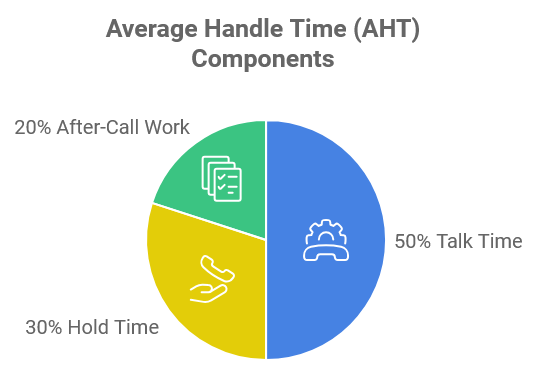
Average Handle Time (AHT) is a crucial BPO KPI that measures the average duration of a customer transaction. It includes talk time, hold time, and after-call work.
- Definition: AHT is calculated by adding total talk time, total hold time, and total after-call work time, then dividing by the number of calls handled. A typical formula would look like this: AHT = (Total Talk Time + Total Hold Time + After-Call Work Time) / Number of Calls.
- Importance: A shorter AHT means more efficient handling of customer interactions, leading to higher customer satisfaction and reduced operational costs.
- Examples: If a call center processes 1000 calls per day, a reduction of 10 seconds in AHT can save up to 10,000 seconds daily, allowing for more calls to be handled efficiently.
Pro Tip
Leverage AI-driven tools to assist agents in quickly accessing the information they need, which can significantly reduce AHT.
First Call Resolution (FCR)
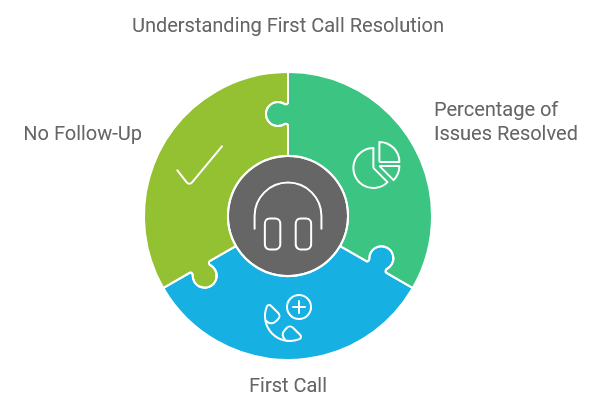
First Call Resolution (FCR) measures the percentage of customer issues resolved within the first call without the need for a follow-up.
- Definition: FCR is calculated by dividing the number of calls resolved on the first attempt by the total number of calls, then multiplying by 100 to get a percentage.
- Importance: High FCR rates are indicative of effective customer service. They lead to higher customer satisfaction, reduced operational costs, and improved agent efficiency.
- Examples: A call center with an FCR rate of 80% likely experiences fewer repeat calls and higher customer retention rates.
Pro Tip
Provide ongoing training and easy access to a well-documented knowledge base for agents to improve FCR rates.
Customer Satisfaction Score (CSAT)
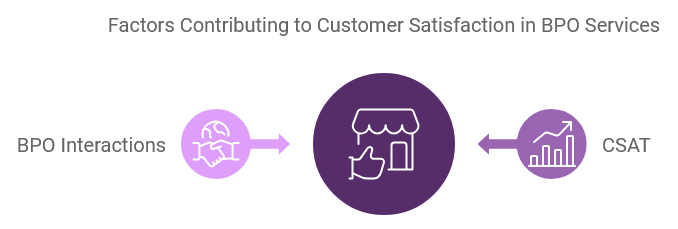
Customer Satisfaction Score (CSAT) gauges the level of satisfaction customers feel after interacting with a BPO service.
- Definition: CSAT is usually measured by asking customers to rate their recent interaction on a scale, commonly from 1 to 5, with 5 being the highest satisfaction level. The formula is: CSAT = (Number of Satisfied Customers / Total Number of Surveys) x 100.
- Importance: High CSAT scores reflect a positive customer experience, which can result in increased customer loyalty and word-of-mouth referrals.
- Examples: A BPO with a CSAT score of 90% likely enjoys high customer retention and reduced churn rates.
Pro Tip
Conduct regular CSAT surveys and use the insights to continuously refine customer service processes.
Service Level (SL)
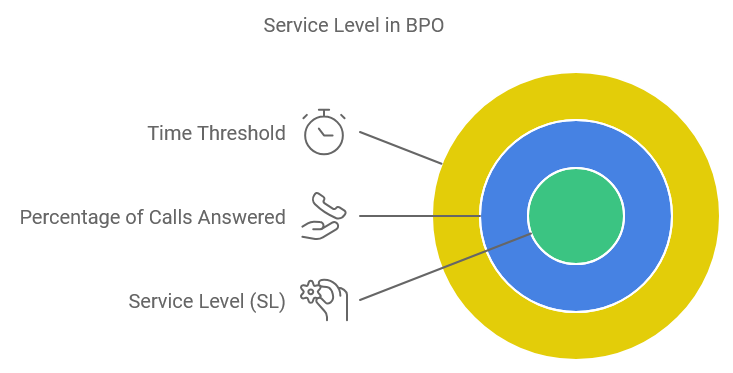
Service Level (SL) is a BPO KPI that measures the percentage of calls answered within a predetermined threshold. For example, answering 80% of calls within 30 seconds.
- Definition: SL is calculated by dividing the number of calls answered within the threshold by the total number of calls received, then multiplying by 100.
- Importance: Maintaining a high service level ensures that customers are not kept waiting, which enhances customer satisfaction and reduces call abandonment rates.
- Examples: A call center with an SL of 90/30 (90% of calls answered in 30 seconds) is likely providing a responsive service, leading to higher customer satisfaction.
Pro Tip
Use real-time monitoring tools to keep track of service levels and make necessary staffing adjustments during peak times.
Net Promoter Score (NPS)
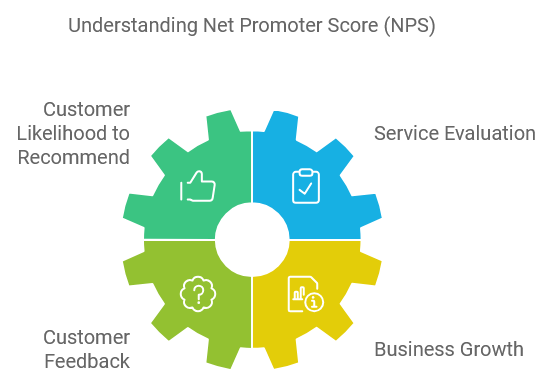
Net Promoter Score (NPS) measures the likelihood of customers recommending your service to others.
- Definition: NPS is calculated by asking customers to rate their likelihood of recommending the service on a scale from 0 to 10. NPS = % of Promoters (score 9-10) – % of Detractors (score 0-6).
- Importance: A high NPS suggests strong customer loyalty, which can drive business growth through referrals and repeat business.
- Examples: A BPO with an NPS of 70 is likely to benefit from a strong base of loyal customers who are advocates of their services.
Pro Tip
Address the concerns of detractors promptly and follow up with promoters to understand what is working well.
Employee Engagement Score
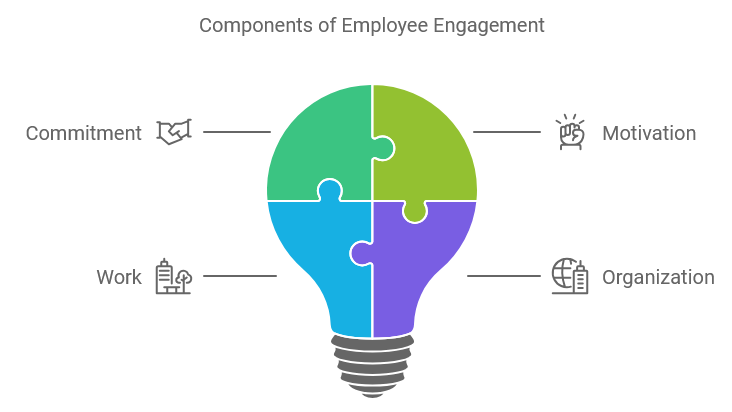
Employee Engagement Score is a KPI that measures how committed and motivated employees are towards their work and the organization.
- Definition: This is usually measured through surveys that assess employees’ involvement, enthusiasm, and satisfaction with their roles and the company. The score is typically an average of responses to various engagement-related questions.
- Importance: High employee engagement can lead to increased productivity, lower turnover rates, and improved customer service.
- Examples: A call center with high employee engagement scores is likely to enjoy lower absenteeism and higher performance levels.
Pro Tip
Regularly conduct engagement surveys and implement initiatives based on the feedback to foster a positive work environment.
Cost Per Hire
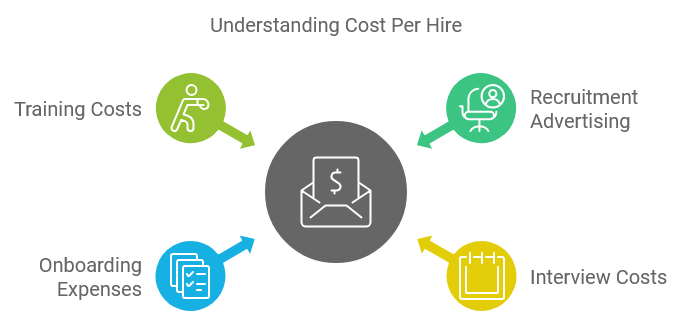
Cost Per Hire is a financial KPI that measures the average expense of hiring a new employee.
- Definition: Cost Per Hire is calculated by dividing the total recruitment costs (advertising, recruiter fees, training, etc.) by the number of new hires.
- Importance: Keeping this cost low without compromising quality helps maintain the overall financial health of the organization.
- Examples: A BPO with a cost per hire of $2000 effectively manages recruitment expenses, which can lead to better resource allocation.
Pro Tip
Utilize employee referral programs to reduce recruitment costs and find candidates who fit the company culture.
Call Abandonment Rate
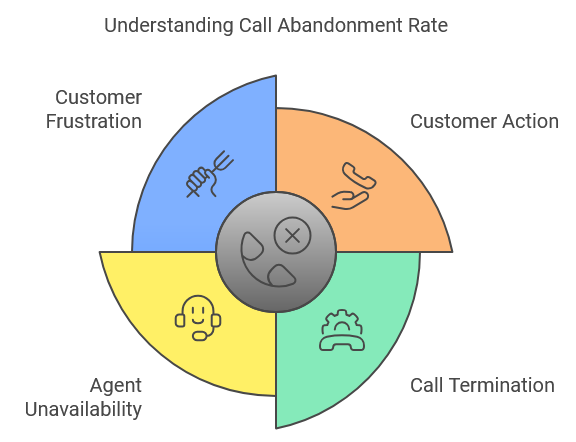
Call Abandonment Rate is the percentage of calls that are terminated by the customer before speaking to an agent.
- Definition: Call Abandonment Rate is calculated by dividing the number of abandoned calls by the total incoming calls, then multiplying by 100.
- Importance: High call abandonment rates indicate a poor customer experience and can be detrimental to customer satisfaction.
- Examples: A call center with a low call abandonment rate (e.g., below 5%) indicates that customers are willing to wait for service, a sign of good operational performance.
Pro Tip
Implement callback options or virtual hold to reduce abandonment rates during high call volumes.
Quality Assurance (QA) Score
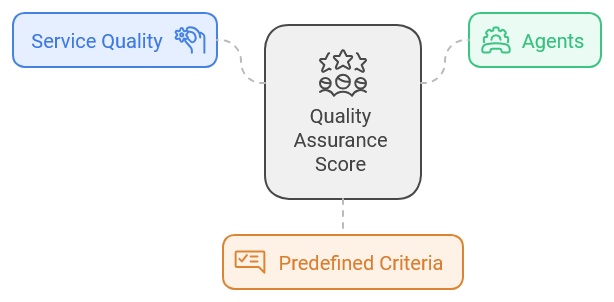
Quality Assurance Score measures the quality of service provided by agents based on predefined criteria.
- Definition: QA Score is calculated by evaluating calls against a checklist of quality parameters such as adherence to script, customer handling tone, and accuracy of provided information.
- Importance: Maintaining high QA scores ensures that customers receive consistent and high-quality service.
- Examples: A BPO with a high QA score (e.g., above 90%) consistently delivers excellent service, which can boost customer satisfaction and loyalty.
Pro Tip
Regularly review and update quality criteria to ensure they align with evolving customer expectations and business goals.
Attrition Rate
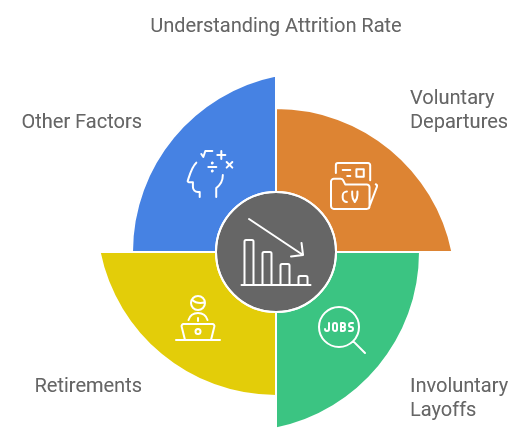
Attrition Rate is the percentage of employees that leave the organization over a certain period.
- Definition: Attrition Rate is calculated by dividing the number of separations by the average number of employees during the period, then multiplying by 100.
- Importance: High attrition rates can be costly and disruptive, affecting the quality of service and increasing recruitment expenses.
- Examples: A BPO with a low attrition rate (e.g., below 10%) indicates strong employee satisfaction and organizational stability.|
Pro Tip
Focus on employee development and recognition programs to retain top talent and reduce attrition rates.
In conclusion, tracking and managing these key BPO KPIs is crucial for optimizing your call center or BPO operations. By paying close attention to these metrics, you can ensure high levels of customer satisfaction, employee engagement, and overall operational efficiency.
Regularly monitoring these KPIs and implementing data-driven strategies for improvement will propel your business towards greater success.
Pro Tip
Invest in a robust KPI monitoring system that provides real-time analytics to stay ahead of potential issues and continuously improve performance.
By keeping an eye on these KPIs, you can fine-tune your operations, driving both customer and employee satisfaction while optimizing costs and resources. Start tracking these KPIs today and transform your BPO into a customer-centric, high-performance organization.
Ready to take your BPO operations to the next level? Begin by assessing your current performance against these KPIs and set actionable goals for improvement. Remember, the key to long-term success lies in continuous monitoring, learning, and adapting to the ever-changing business landscape.
Start your outsourcing company’s transformation today!
Say hello to productivity, accuracy, and profitable growth. Streamline your operations and project management with HiveDesk.
